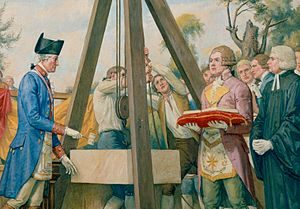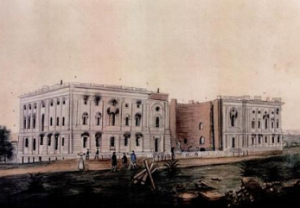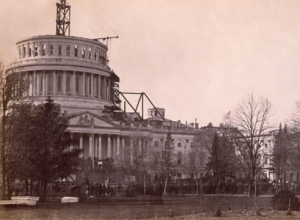
 Most people know what the United States Capitol building looks like, and many have seen it, and even been inside it, but I wonder how many people know that is almost wasn’t completed. Yes, you heard me right. I almost wasn’t completed. As a young nation, the United States had no permanent capitol, and Congress met in eight different cities, including Baltimore, New York and Philadelphia, before 1791. In 1790, Congress passed the Residence Act, which gave President Washington the power to select a permanent home for the federal government. The following year, he chose what would become the District of Columbia from land that had been provided by Maryland. Washington picked three commissioners to oversee the capital city’s development and they in turn chose French engineer Pierre Charles L’Enfant to come up with the design. However, L’Enfant clashed with the commissioners and was fired in 1792. A design competition was held, and a Scotsman named William Thornton submitted the winning entry.
Most people know what the United States Capitol building looks like, and many have seen it, and even been inside it, but I wonder how many people know that is almost wasn’t completed. Yes, you heard me right. I almost wasn’t completed. As a young nation, the United States had no permanent capitol, and Congress met in eight different cities, including Baltimore, New York and Philadelphia, before 1791. In 1790, Congress passed the Residence Act, which gave President Washington the power to select a permanent home for the federal government. The following year, he chose what would become the District of Columbia from land that had been provided by Maryland. Washington picked three commissioners to oversee the capital city’s development and they in turn chose French engineer Pierre Charles L’Enfant to come up with the design. However, L’Enfant clashed with the commissioners and was fired in 1792. A design competition was held, and a Scotsman named William Thornton submitted the winning entry.
Then, on this day, September 18, 1793, Washington laid the Capitol’s cornerstone and the lengthy construction process, which would involve a line of project managers and architects, got under way. One would think that is due time, the capitol building would be finished, but in reality, it took almost a century to finish…almost 100 years!! During those years, architects came and went, the British set it on fire, and it was called into use during the Civil War. In 1800, Congress moved into the Capitol’s north wing. In 1807, the House of Representatives moved into the building’s south wing, which was finally finished in 1811. During the War of 1812, the British invaded Washington DC. They set fire to the Capitol on August 24, 1814. Thankfully, a rainstorm saved the building from total destruction. Congress met in nearby temporary quarters from 1815 to 1819. In the early 1850s, work began to expand the Capitol to accommodate the growing number of Congressmen. The Civil War halted construction in 1861 while the Capitol was used by Union troops as a hospital and barracks. Following the war, expansions and modern upgrades to the building continued into the next century.
Today, the Capitol building, with its famous cast-iron dome and important collection of American art, is part of the Capitol Complex, which includes six Congressional office buildings and three Library of Congress buildings, all developed in the 19th and 20th centuries. The Capitol, which is visited by 3 million to 5 million people each 
 year, has 540 rooms and covers a ground area of about four acres. I’m sure that those who visit the United States Capitol Building probably hear all about it strange past and its construction history, but maybe not. I suppose that it depends on what the tour guide finds interesting. Personally, I like the unusual construction. Thankfully, the United States Capitol did finally get built and has become the beautiful building we know today.
year, has 540 rooms and covers a ground area of about four acres. I’m sure that those who visit the United States Capitol Building probably hear all about it strange past and its construction history, but maybe not. I suppose that it depends on what the tour guide finds interesting. Personally, I like the unusual construction. Thankfully, the United States Capitol did finally get built and has become the beautiful building we know today.


2 Responses to The Capitol Building That Almost Wasn’t